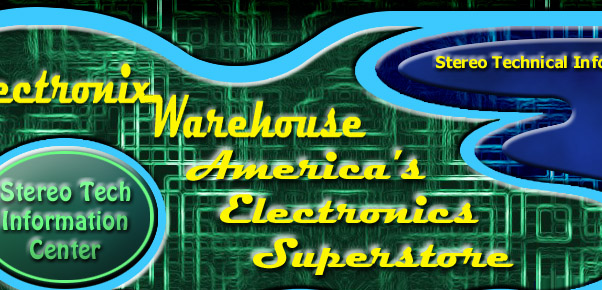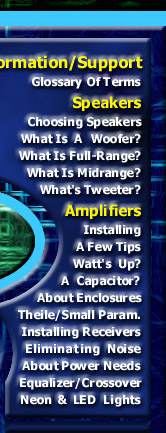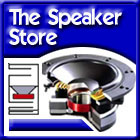




Technical
Help
& Education
Glossary Of Terms
Speakers Main Page
How Speakers Work
Choosing Speakers
What's A Woofer?
What's A Midrange?
What's A Tweeter?
Other Speaker Types
More Speaker Types
What's A Capacitor?
Installing A Capacitor
What's A Crossover?
What's An Equalizer?
Speaker Enclosures
Theile/Small Param.
About Power Amps
Installing An Amp
Installation Tips
Power Ratings
Installing/Replacing
Head Units/Receivers
Installing Neon/LED
Eliminating Noise
Use The Right Tools
Manufacturer's
Links
Personal
& Marine
Electronics
Laptop Computers
Cell Phones & PDAs
Portable TV & Video
Electronic Readers
MP3/Music Players
CD
Players/Booms
Earphones/Buds
Digital Cameras
Video
Cameras
Personal GPS
Bluetooth
Calculators
Accessories
Marine
Electronics
Stereo Amplifiers
Stereo Speakers
Stereo Woofers
Enclosed Speakers
TVS & Video
CD/Mp3 Receivers
GPS & Navigation
Fish Finders
Accessories
Home
Stereo &
Office Electronics
Flat
Screen & HD TVs
Surround Sound
Home Theater
DVD Players/Tivo
DVD Recorders
Blu-Ray Devices
Amplifiers/Tuners
Speaker
Systems
Subwoofer Drivers
Midrange
Drivers
Tweeter Drivers
Powered Subwoofers
Outdoor
Speakers
Stereo Accessories
Digital
Photo Frames
Video Game Systems
Game
Accessories
Video Games
Home Security/Alarms
Computer
Products
Desktops & Laptops
Add-Ons/Peripherals
Computer Monitors
Computer Software
Computer Games
Printers &
Scanners
Ink/Specialty Papers
Parts & Components
Computer Supplies
Security/Tech
Support
Auto
Electronics
Amplifiers
Subwoofers
Full-Range Speakers
Midrange Speakers
Tweeters
Power Capacitors
Empty
Enclosures
Loaded Enclosures
CD/Mp3 Receivers
CD Changers
Bass Packages
Car
TV & Video
Satellite
Radio
Bluetooth Wireless
GPS Navigation
Neon/LED Lighting
Radar Detectors
Chrome
Mufflers
Car Alarms/Security
V
AUTO
PARTS STORE
Auto
Wiring &
Accessories
Air Horns
Power
Antennas
Antenna Boosters
A/V Controllers
Bass Blockers
Crossovers
Dynamat
Equalizers
Fans (Cooling)
FM Modulators
Interfaces
Line Converters
Noise Filters
Power Inverters
Power Supplies
RCA Cables
RCA Splitters
Remote Controls
Signal Boosters
Vibration Control
Speaker Grills
Wiring Kits
Speaker Boxes & Enclosures
Wondering what is meant by Sealed, Ported, Bass Reflex, Acoustic Suspension? These are all types of speaker enclosures or boxes, and all of these enclosure types are "direct radiator" enclosures. They are called this because the sound is produced directly from the "radiator" (the driver or speaker) without the assistance of a contrivance such as a horn. Other types such as, Bandpass, and Coupled Cavity enclosures are similar, but more complex.
Cardinal Rules for Enclosure Building
1. Build only for the internal volume size recommended by the woofer manufacturer.
2. Make the construction (sealed or ported) air-tight.
3. It is invariably more advantageous to buy, rather than build, both economically and to assure quality of construction. If you are an experienced cabinet maker with the proper tools, it will make a good project, otherwise....
Note, that enclosures exist solely for the purpose of accommodating the woofer. Tweeters and midranges do not have to be enclosed at all, though for the sake of convenience they are often mounted in enclosures along with the woofer. To help you decide which type is best for your purposes, we offer below some detailed explanations and illustrations of each type, along with information on the types of materials used in their construction and a few suggestions.
SEALED
BOX

The simplest direct-radiator system. The rear of the driver is in
a sealed enclosure, and none of the rear output of the driver contributes
to the sound output. Depending upon how stiff the mechanical suspension
is Vs how stiff the enclosed air in the enclosure is (and that's a function
of the size of the box), you can have one of two enclosure types: either
an Infinite Baffle enclosure, in which the mechanical suspension is
the dominant source of system stiffness and the box is large; or an
Acoustic Suspension enclosure, where the air in the box is the dominating
stiffness and the box is small. Sealed boxes tend to be among the lowest
efficiency systems for a given box size and bass cutoff frequency. They
are however quite good at reproducing a fairly broad range with little
deviation or distortion.
VENTED
ENCLOSURES

Also the same as Bass Reflex, Ported, or Passive Radiator. Here, an
aperture or port in the box provides a means for the rear output of
the cone to contribute to the total output of the system. However, it
only contributes over a very narrow range of frequencies. In fact, in
a properly designed system, the front output of the cone is reduced
at the same time the output of the port increases. Consequently the
port does not re-enforce the output of the woofer; it REPLACES the output
of the woofer at these frequencies. If done properly, this can significantly
reduce distortion and increase power handling at very low frequencies,
a region that can be difficult for drivers. A vented system can be up
to 3 dB more efficient at certain frequencies than a sealed box system
that has the same bass cutoff frequency and size.
BANDPASS

These are compound systems in that they have at least two enclosures:
one on the front and one on the rear of the driver. The enclosure on
the front, which looks remarkably like a vented box (because it is),
acts as a low pass filter and can couple the output of the woofer more
efficiently to the outside. They have several useful advantages. For
example, the front enclosure can be used as a very effective acoustic
crossover, filtering out mechanical noises generated by the woofer,
something no electronic crossover can do. For very low frequencies,
such an acoustic crossover can be far less expensive and more easily
designed than an equivalent electronic crossover. They are called "Bandpass"
because the combination of the rear enclosure and the driver form the
high pass portion while the front enclosure forms the low pass section.
Making the bandwidth of the system narrower raises the efficiency of
the system.
COUPLED
CAVITY

A variation of Bandpass and vented systems, the coupled cavity enclosure
is the result of attempts by designers to solve specific problems. These
enclosures consist of two or more rear enclosures, each coupled to the
next by a vent. Each enclosure/vent combination is another resonant
system, and the combination is, essentially, a high order, multi-tuned
resonant system. Generally, these systems have quite complex response
and are difficult to design. No comprehensive theory on their operation
exists like that for sealed, vented and Bandpass systems.
IMPEDANCE MATCHING IS IMPORTANT
Many builders and users like to take advantage of the power advantages of operating the amplifier in bridged or mono mode. To do so however, means that the impedance requirement of the drivers be taken into account when designing a proper circuit. For this purpose, we have provided an impedance calculator
MATERIALS
What is the best material to make speaker boxes? An ideal speaker cabinet
material would be very stiff, so that it would
tend to be stable with variations in box air pressure. It would also
be very well damped, so that if it ever does deflect from air pressure,
it will come back to the original position without resonating.
In addition, it would have a very high resonant frequency (supersonic),
so that low frequency box air pressure would not cause it to resonate.
An attractive material is preferred, and additional credit is given
for a material that is easy to cut, glue, and finish. A great material
would be cheap, too. Finally, it would be nice if the material were
light, because we all have to move our speakers sometimes, and it's
hard to appreciate good speakers with a sore back.
With
all of those attributes, it would seem that no material is perfect.
However, there are many materials that have enough of the above good
attributes to make excellent speaker cabinets. Each, however, has advantages
and disadvantages. In the list of good speaker box materials below,
the following code letters are used to indicate which attributes the
material possesses:
S
= Stiff -
D
= Damped -
H
= High Resonance
A
= Attractive -
M
= Malleable
C
= Cheap -
L
= Light.
MEDIUM
DENSITY FIBERBOARD (MDF)
Code:
SDMC
This is the most practical material for quality speaker enclosures.
It's extremely rigid and resistant to sympathetic vibrations in thicknesses
over half an inch. It cuts very nicely and has a smooth surface. It
takes veneer very well. However, bring a helper when you pick the stuff
up; one sheet is very heavy. MDF is harder on tools than common wood,
but easier than particle board. This is the material that many great
speaker makers use. Approximately $45 for a 4'x8'x1" sheet. Density:
50-lbs./Cu. ft.
POLYCARBONATE
(LEXAN)
Code:
DMA
A clear or solid-color polycarbonate box can look strikingly good. However,
this is not a cheap material. To locate it, look in the classified directory
under PLASTICS. Approximately $400 for a 4'x8'x0.5" sheet. Density:
75-lbs./Cu. ft. Acrylic (Plexiglas) is cheaper than Polycarbonate, but
weaker and not as well damped (not recommended as a main construction
material, but used for "windows" in Bandpass enclosures).
PLYWOOD
SPACED AND FILLED WITH SAND OR LEAD SHOT
Code:
SDAMC
Not a good choice for Car stereo because of weight issues.
If you have time on your hands and want a great impractical box, try
this. Make a simple box out of common plywood. Then glue cleats on the
outside of the box to space the outside plywood from the common plywood.
Glue hardwood-veneered plywood to the cleats and pour sand or lead shot
into the spaces between the cleats. It won't be light, but with the
filler, it will be extremely well damped. In addition, if you use strong
cleats and glue well, the box will be extremely stiff. One designer
was known to use different size Sonotubes as an alternative to plywood,
and filled the space between them with sand. Be sure to sterilize the
sand in your oven before putting it in the box.
ALUMINUM
SHEETS FILLED WITH ALUMINUM HONEYCOMB (Aerolam)
Code:
SDHL
Airplanes use this material for flooring. Next time a plane crashes
in your neighborhood, see if you can get the wreckage for your next
speaker project. You can't get a better, lightweight material. If you're
really ambitious, you can make your own sandwich out of high-quality
plywood faces and a thick honeycomb core. You will probably need an
epoxy to glue the honeycomb to the plywood. A home-brew sandwich is
easier to cut and glue than Aerolam.
FORMED
CONCRETE
Code:
SDHC
Not a good choice for car speakers due to weight. There are tricks to
working concrete, such as to cast braces, rebar, and steel-wire right
into the mix. Also, some types of concrete are better damped than others.
Remember to oil your concrete forms so that they can be removed. Most
concrete speakers use an MDF front panel, but you can pour one if you
use cardboard tubes or plywood rings to mold the concrete into the shape
of a speaker cutout.
Alternately, you can make a common veneered plywood speaker box and cast concrete inside it for stiffening. Any box can be improved by making the walls thicker, by bracing the walls, and by stiffening the walls. The stiffness of a material goes up as the cube of the thickness, so a slightly thicker material is much stiffer. A thicker panel will also have a higher resonant frequency because the stiffness goes up faster than the mass. Consider lining the inside of your speaker with ceramic tile, attached with thinset mortar. You can get tile remnants cheaply. They are easy to apply and can be added as an afterthought to an imperfect box. However, be sure to attach all braces before tiling, because it is hard to attach anything to tile. Also consider bracing any weak parts of the box. For example, all joints will benefit from a wooden cleat. The back of the box will benefit from stiffeners where the speaker terminals are attached. Most importantly, brace the front panel, or make it out of a double thickness of material.
For
a great deal more particular information along with interactive calculators
on speaker construction see:
Articles at the
Best Car Electronics
Theory Site
MAIN
PAGE
GLOSSARY
SPEAKERS:
Choosing
General
Woofers
Miidrange
Tweeters
Full-Range
Full-Range 2
CAPACITORS
CROSSOVERS
EQUALIZERS
Theile/Small
AMPLIFIERS:
About
Installing
Install Tips
Power Ratings
RECEIVERS:
Installing
NEON/LED:
Installing
TOOLS
Home
--
Policies
--
Products
--
Tech
Center
--
Auto
Electronics
--
Home
Electronics
--
Personal
& Marine Electronics
--
Stereo
Tech Info
Website Designed & Maintained by
MetroDirect
Communications
Copyright (c) 2000 - 2009
Electronixwarehouse.com
.
Use of any material appearing on this site without specific written
permission is prohibitied by law.
electronixwarehouse.com
---
logobannerfactory.com
---
bleepthem.com (Political Satire)
---
rlebeaux.com
---
stereotechnicalinformation.com (Stereo
Technical Help)
---
electronixwarehouse.net
---
thespeakerstore.com
---
wmpublishing.com (Help For Writers)
---
barbarathenovel.com
---
cutethenovel.com




